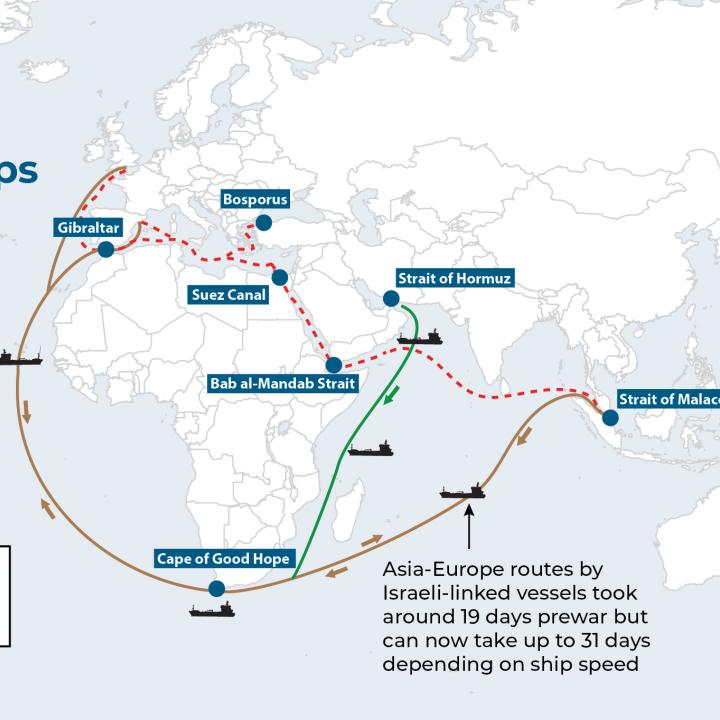Episode 381: European Financiers on Guard Against China, Geopolitical Risks Shadow the Shipping Market
“Clearly, the new orders taken by Chinese shipyards have led to overcapacity. If the stream of new builds from Chinese yards continues as it has, we’ll see the market for container ships, car carriers, LNG carriers, and eventually bulk carriers all collapse.”
In late October, a foreign broker made this sharp observation during an outdoor gathering hosted by an international shipping company in a refreshingly cool Tokyo.
(Text by Hiro Yamamoto)
Photo courtesy=The Washington Institute, CSSC, OFAC

■Excessive Orders at Chinese Shipyards
On October 10, China’s Ministry of Industry and Information Technology (MIIT) released data on the completion volume, new order volume, and order backlog of Chinese shipyards for January through September 2024.
According to MIIT, Chinese shipyards accounted for 55% of the global newbuild completion volume, 74% of new orders, and 61% of the order backlog, ranking them first worldwide in all three major indicators of shipbuilding activity.
“Recently, China has been ramping up production of mid-sized bulk carriers like Kamsarmax and Supramax vessels. The strong support of the Chinese government is evident in the ample financing for ship loans and the expansion of shipyard facilities,” said a shipping department representative from a trading company.
It’s apparent that the volume of orders at Chinese shipyards has reached overcapacity.
Despite soaring new-build prices driven by global material cost increases, the Chinese government continues to channel funds into shipping and shipbuilding.
But what is the Chinese government’s intention?
The aforementioned representative elaborated:
“The Chinese government is desperate to reverse the domestic real estate downturn and sustain economic growth. Shipping and shipbuilding are ideal investment fields for the current government due to the significant capital, equipment investment, and workforce they require. Additionally, from an economic security perspective, becoming a global key player in shipping and shipbuilding offers several advantages for the Chinese government.”
China’s grip on the global shipbuilding market is apparent. The Chinese government envisions itself as a “key figure in economic security.” However, will things go according to plan?

■ Concern Over Potential Sanctions
In mid-to-late October, Tokyo hosted several key maritime events, including the Global Maritime Forum (GMF) annual meeting, the Shipowners Forum Tokyo by UK-based TradeWinds, and a financial seminar by US Capital Link.
Shipowners from Greece and Denmark, as well as representatives from European brokerage, finance, and maritime equipment manufacturing companies, gathered in Japan.
Their whispered topic of concern was also “Chinese shipbuilding.”
A Greek shipowner commented:
“Chinese shipyards have increased their presence in large container ships, LNG carriers, and car carriers. However, when it comes to bulk carriers, they still lag behind Japanese shipyards in technical expertise. Moreover, their output remains limited.”
But is that really the case?
China has been rapidly establishing not only state-owned but also private shipyards. Chinese yards are now capable of producing a wide range of bulk carriers, from Kamsarmax and Supramax to Handymax. If all the newly ordered bulk carriers at Chinese yards enter the shipping market, “the dry bulk market could face not only softening but also a long-term surplus,” said a European broker.
The current stability of the shipping market relies heavily on “geopolitical risks.”
How long will the blockage of the Suez Canal continue? Will the gas pipeline from Russia to Europe remain offline for decades?
A trading company representative explained:
“There’s no doubt that the biggest geopolitical risk is China. Depending on the outcome of the U.S. presidential election, the Office of Foreign Assets Control (OFAC) could intensify financial sanctions on China. In fact, some European financial institutions have temporarily suspended financing for Chinese ship orders by foreign shipowners due to concerns about potential OFAC sanctions,” said a shipping department official.
If the new ships being built at Chinese shipyards are completed as scheduled, the market collapse would be unavoidable.
On the other hand, if OFAC enacts sanctions or if a “Taiwan contingency” occurs, it’s conceivable that no new ships would emerge from Chinese shipyards at all.
Japanese shipping giants and shipowners have also placed numerous new orders with Chinese shipyards. Should the construction of these new vessels, costing 5 to 10 billion yen each, be abandoned, the economic loss would be immeasurable. In fact, during the 2008 Lehman Shock, many private Chinese shipyards went bankrupt or faced insolvency.
China, swayed by geopolitical risks, continues to receive government support for its shipbuilding industry.
It’s fair to say that the global shipping market is in a state of high vulnerability to geopolitical risks.

ルポルタージュ、国内船主の“今”
第381回、欧州金融、中国を警戒。地政学リスク 海運市場に影
「中国造船所の新造船受注量は明らかにオーバートンネージ(過剰船腹量)だ。このまま新造船が中国造船所から竣工してくれば、まずはコンテナ船、自動車船、LNG(液化天然ガス)船、最後にはバルカー市況が崩壊する」
10月下旬、ようやく秋らしい涼しさが漂った東京都内。海外船社が開催した屋外でのパーティーで海外ブローカーが鋭く指摘した。
■中国造船の過剰受注
中国工業情報化部(MIIT)は10月10日、2024年1―9月の中国造船所の竣工量、新規受注量、受注残高の実績をそれぞれ発表した。
それによると、中国造船の新造船の竣工量は世界全体の55%、新規受注量は74%、受注残高は61%を占め、主要な造船指標の3部門で世界首位に立つ。
「中国は最近、カムサマックス、スープラマックスといった中小型バルカーの建造にも力を入れている。中国政府の強力な後押しが潤沢な船舶融資の資金力、造船所の設備増強に表れている」(商社船舶部)
※日本語記事の続きは日本海事新聞でお読みください。
